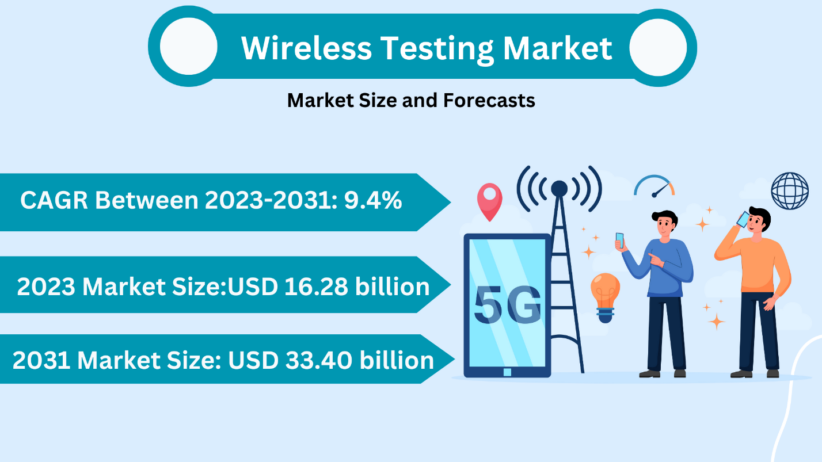The arrival of 5G is changing how we are connected to the world. Fast speeds, low latency, and the ability to connect up to 1 million devices per square kilometer—all with the promise of 5G—the technology that will revolutionize everything from smart cities to self-driving vehicles to healthcare. But as 5G is a fact of life, so too are new difficulties with wireless testing. The worldwide wireless testing market is estimated to reach USD 16.28 billion by 2023 and USD 33.40 billion by 2031, growing at a CAGR of 9.4%. With demand for 5G increasing, high-end wireless test tools are more important than ever. In this blog, we will look at the way 5G changes wireless testing, challenges, and how market updates can give new growth prospects to enterprises.
The Increasing Demand for Wireless Testing in the 5G Era
The world is moving to 5G networks, and there’s a new demand for sophisticated wireless testing market. For the first time in history, 5G is complex enough that new testing protocols need to be implemented to make sure devices and networks can function and behave properly. That wireless testing question, for simple functionality, is a whole other ballgame now — performance at extreme conditions, compatibility with millions of devices, and compliance with all the regulations.
Testing of 5G-enabled devices and networks is especially challenging because 5G devices offer massive data speeds, ultra-low latency, and high-frequency millimeter waves. These factors require more detailed testing techniques that will measure not only basic functionality but also performance across a range of real-world scenarios, such as signal interference and network congestion. With increasing demand for 5G technology, businesses must ensure that their products are completely tested for quality and performance before entering the market.
5G and Wireless Testing: How Wireless Testing Market Makes Businesses Successful in the 5G Age.
Businesses need to adapt to a new world of wireless testing if they are going to survive in this rapidly changing world. Wireless testing also helps companies bring 5G products to market that can perform well in a highly demanded, complex ecosystem. And as 5G promises to power everything from self-driving cars to connected cities and smartwatches, the demands for interoperability are higher than ever. Each device needs to work perfectly on top of each other and over multiple network environments.
Core to wireless testing is performance testing—whether or not 5G devices deliver on the speed, connectivity, and latency promised by the technology. Wireless testing is also used by businesses to check devices for signal quality, data transfer rate, battery life, and more. These tests mimic actual conditions so devices give you the best possible user experience no matter where or how you use them.
Geographical Growth and Global Coverage
The global expansion of 5G networks is driving demand for the wireless testing market, particularly in regions with large consumer bases like North America, Europe, and Asia-Pacific. Countries such as China, South Korea, and Japan are leading 5G deployment, while the U.S. and Canada also see growing demand for testing solutions. Additionally, emerging markets in Latin America, the Middle East, and Africa are expected to experience significant growth as 5G technology spreads.
NSF Investments in Wireless Test and O-RAN Development.
In the U.S., the National Science Foundation (NSF) has awarded $7 million to expand its Platforms for Advanced Wireless Research (PAWR) program to further test Open Radio Access Network (O-RAN) networks. This funding helps develop Open Testing and Integration Centers (OTICs) and open O-RAN testing. It is compliant with the “CHIPS and Science Act of 2022” and will be used to speed up open-source solutions for 5G and 6G networks. The investment also invests in rural connectivity and drone communications to increase innovation in rural areas and foster academic research and startups.
Emerging Trends in Wireless Testing for 5G
The wireless testing market is also changing as 5G progresses. As the industry reorients itself, some trends are driving wireless testing’s future. Machine learning (ML) and AI are taking over wireless test methodologies by automating symptom discovery, creating test cases, and even warning of network failure before it occurs. This AI-accelerated testing speed, eliminating human error, is especially important as enterprises scale operations to satisfy the global market for 5G devices.
The other trend changing the wireless testing industry is cloud-based testing platforms. These are the tools by which companies can experiment with devices and networks from anywhere, anytime without investing in expensive infrastructure. Scalability is also for cloud testing services, and it can easily scale to the sheer number of devices and network configurations 5G requires. It is also possible for businesses to ensure that their products are 100% tested and compatible, efficient, and safe in all regions and under any conditions with cloud solutions.
Moreover, end-to-end testing has become a necessity for 5G networks. Companies are no longer testing only parts but the whole network ecosystem, from the end-user devices to the key network technologies, is being evaluated by businesses. This makes all the components of the system work in harmony for the 5G that is promised.
Challenges in Wireless Testing Market for 5G and How to Overcome Them
There are many positive aspects of 5G and also some challenges for companies that need to make sure the products and networks are in working order. Among the biggest hurdles is the cost of special testing equipment for 5G networks. Trying to test machines on millimeter-wave waves, or devices with massive MIMO (multiple-input, multiple-output) technology, you need special test chambers and equipment, and these can be expensive for firms to buy and maintain. To combat this, enterprises can consider cloud-based testing services that not only save the cost of physical infrastructure but also offer access to high-quality, real-time test facilities.
The second issue companies are having is that they need to keep a large number of connected devices in sync. As the IoT gets bigger, it gets trickier to get devices from different makers to function on 5G networks together. What will solve this problem is to have interoperability testing methodologies that allow the devices to communicate even if they’re made by different vendors or using different technologies.
Then, last but not least, there’s the volume of data produced by 5G networks and IOT systems. Data crunching from billions of interconnected devices could be too much for old-fashioned testing. For this, enterprises can adopt AI-based solutions that can sift through vast amounts of data and analyze it in real-time to spot the issues early before they become critical.
The Future Outlook: What Manufacturers Can Benefit from the Wireless Testing Market?
As 5G infrastructure spreads, the wireless testing market will experience robust growth. Manufacturers who adopt the latest testing tools—AI-based solutions, cloud-based platforms, and end-to-end testing—will be able to adapt to this new reality. Companies can use these advanced solutions to speed up the product development cycle, speed time to market, and get into compliance across the globe without losing ground.
Final Remarks
The 5G revolution is here, and so are the new opportunities and threats for the wireless testing market. With new testing solutions in place and ahead of the curve, devices can meet the challenges of the 5G age. Be it with AI-powered automation, cloud testing solutions, or end-to-end testing, wireless testing is the future. Companies that are prepared to adopt these changes will be in the right position for a 5G-powered world in which the market is constantly changing. Is it time for you to up your testing game?
References-
US National Science Foundation- Key Investments in Wireless Testing and O-RAN Innovation
National Telecommunications and Information Administration- Expansion of Open Radio Access Networks (O-RAN)


 ESCÚCHANOS EN LAVIBRANTE RADIO 📻
ESCÚCHANOS EN LAVIBRANTE RADIO 📻















